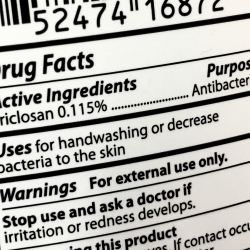A new study shows that a compound found in our tubes of toothpaste may be an effective drug against malaria. This work, done by a group at the University of Campinas (UNICAMP) in Brazil and published in Scientific Reports, shows that the commonly found antimicrobial Triclosan targets a key pathway in Plasmodium and could prove an effective therapeutic.
Malaria, caused by infections with the Plasmodium parasite, is responsible for over half a million deaths each year across the world. The vast majority are children in Africa. Ninety percent of cases are caused by Plasmodium falciparum. A second Plasmodium, Plasmodium vivax, has a large global distribution mainly in South America and Asia.
There is an urgent need to develop new anti-malarial drugs for two main reasons; 1) drug resistance has arisen against all existing drugs and 2) a vaccine does not seem like a possibility in the near future.
Triclosan is a non-antibiotic, antimicrobial (NAAM) which was present in many (over 2000) over the counter antimicrobial products before its use in hand soaps was banned by the Food and Drug Administration (FDA). It can still be found in some products, primarily in toothpaste.
Testing new compounds in Plasmodium is challenging. To overcome that, the research group developed an assay based on yeast that allowed for screening of compounds that target Plasmodium enzymes. How does it work? The researchers add genes that encode key Plasmodium enzymes into the yeast and then add compounds to the yeast. If the drug targets that particular Plasmodium enzyme, the yeast will not grow. This allows them to analyze how the drug is working on that one enzyme.
An example can be seen in the figure below. In this panel, there are yeast strains that have the enzyme dihydrofolate reductase (DHFR) from Plasmodium cloned into them. DHFR is a key enzyme for making the building block of DNA. Neither Plasmodium nor yeast can live without it.

It is easy to see below that the yeast that has the DHFR from both humans and Plasmodium are killed more quickly by the Triclosan (panel on the right) than without Triclosan (panel on the left.) But, what is even more critical is that the yeast that has the dihydrofolate reductase enzyme from Plasmodium (the bottom three rows of dots) are killed more quickly than that yeast that has the human form of DHFR (the top row of dots.)
Plasmodium has two lifecycle stages in humans - the hepatic stage when it reproduces in the host's liver cells, and the erythrocytic stage when it infects red blood cells. Triclosan could be effective against both stages, making the discovery that it targets DHFR and its potential as a therapeutic even more exciting.
Source: Bilsland, E. et al. Plasmodium dihydrofolate reductase is a second enzyme target for the antimalarial action of triclosan Scientific Reports volume 8, Article number: 1038 (2018) doi:10.1038/s41598-018-19549-x

